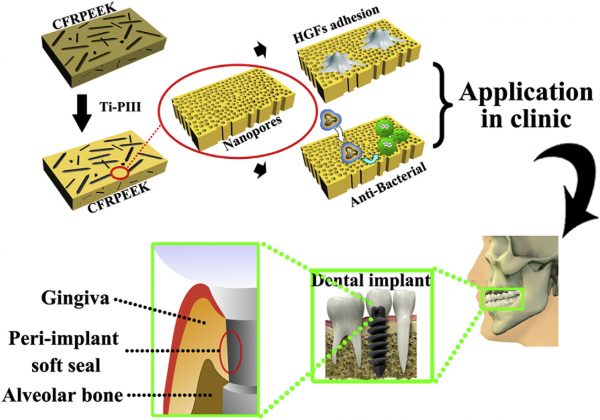人牙龈成纤维细胞和细菌对多层纳米TiO2修饰的碳纤维增强聚醚醚酮的选择性应答

Biomaterials 83 (2016) 207e218
|
牙种植体的长期成功不仅依赖于稳定的骨整合,也依赖于种植体与周围软组织面的结合。以往工作中,钛等离子体浸没离子注入技术成功应用于修饰碳纤维增强聚醚醚酮(CFRPEEK)表面,形成了一种独特的多层纳米TiO2结构,因此增强了成骨特性。然而,表面改性和软组织细胞之间的相互作用尚不明确。 这里,中国科学院上海硅酸盐研究所刘宣勇研究员探讨了人牙龈成纤维细胞(HGF)的生物学行为和口腔病原体的表面结构的表面结构,这决定了早期种植体与周围软组织的整合效果。扫描电子显微显示二氧化硅纳米粒子形成的纳米孔隙嵌入在材料的侧壁和底部、增殖试验、划痕试验、实时定量PCR、Western blot和酶联免疫吸附试验(ELISA)展示了改善的细胞粘附、迁移、增殖能力,以及HGF的胶原分泌能力。同时,表面改性结构显示了对变形链球菌、核粒梭形杆菌和牙龈卟啉单胞菌的持续抗菌能力。此研究显示多层纳米TiO2结构可以选择性地增强软组织结合和抑制细菌再生,进一步支持和扩大了碳纤维增强聚醚醚酮在牙科领域的应用。 The long-term success of dental implants relies not only on stable osseointegration but also on the integration of implant surfaces with surrounding soft tissues. In previous work, titanium plasma immersion ion implantation (PIII) technique was applied to modify the carbon-fiber-reinforced polyetheretherketone (CFROEEK) surface,constructing a unique multilevel TiO2 nanostructure thus enhancing certain osteogenic properties. However, the interactions between the modified surface and soft-tissue cells are still not clear. Here, Xuanyong Liu who works in the Shanghai Institute of Ceramics of Chinese Academy of Sciences investigates the biological behaviors of human gingival fibroblasts and oral pathogens on the structured surface , which determine the early peri-implant soft tissue integration. Scanning electron microscopy (SEM) shows the formation of nanopores with TiO2 nanoparticles embedded on both the sidewall and bottom. In vitro studies including cell adhesion, viability assay, wound healing assay, real-time PCR, western blot and enzyme-linked immunosorbent assay (ELISA) disclose improved adhesion, migration, proliferation, and collagen secretion ability of HGFs on the modified CFRPEEK. Moreover, the structured surface exhibits su stainable antibacterial propertie properties towards Streptococcus mutans, Fusobacterium nucleatum and Porphyromonas gingivalis. These results reveal that the multilevel TiO2 nanostructures canselectively enhance soft tissue integration and inhibit bacterial reproduction, which will further support and broaden the adoption of CFRPEKK materials in dental fields. (朱宇航) |